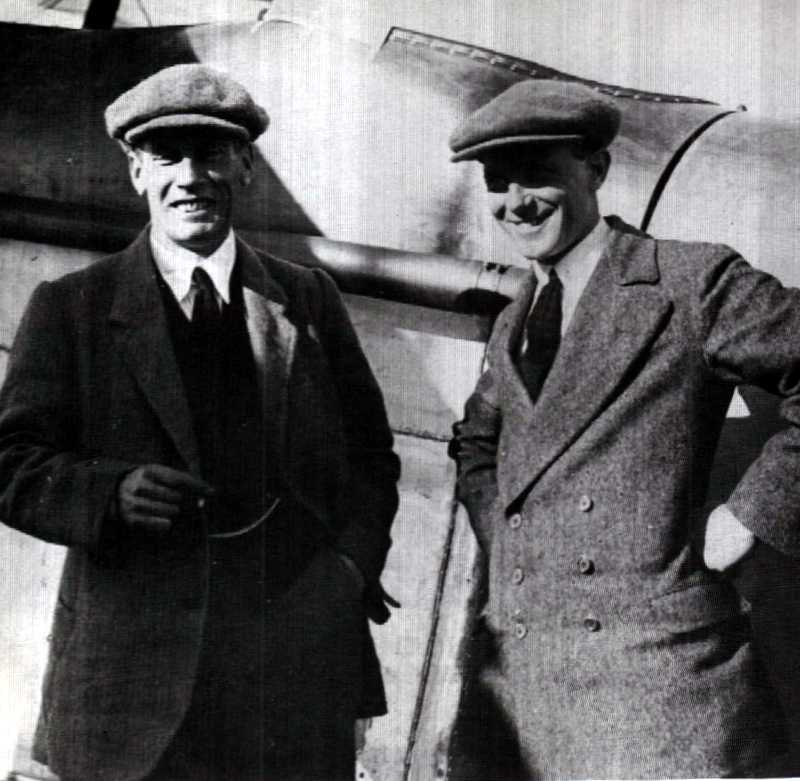
Team Hawker and Grieve, Sopwith Atlantic
Hawker and Grieve were the first British team to enter the race.
Accompanied by a Rolls-Royce expert and a ‘Cinema man’ from Messers Jury’s, Hawker and Grieve departed England on 10 March 1919 on the SS Digby. After a rough crossing, they arrived at Placentia Bay in Newfoundland on 28 March. The heavy crates were then transported to St Johns by rail, road and horse drawn wagons. The best field they could find at St John's was near Mount Pearl, and still very rough, which would prove difficult for take-off, as it could not be used in certain wind directions. The Atlantic was rebuilt in about one week in a wooden hangar erected for that purpose.
With news of the arrival of the three NC Seaplanes at Trepassey, the pressure to be ready for an attempt certainly increased for the British teams. Soon after, additional news was received that one of the three NC sea planes had made it to the Azores. This news made Harry determined to take off if the weather allowed.
Hawker and Grieve took off from a field in Mount Pearl, Newfoundland on May 18, 1919.
Learn more about this exciting expedition which occurred 100 years ago this year of 2019.

HAWKER AND GRIEVE.
The world is richer by two heroic lives. For nearly a week it has believed that It was richer by two noble deaths. It would have cherished the memory of Hawker and Grieve, as it cherishes the memory of Hudson and Andree, and so many other incomparable adventurers; but to be able . •
to cherish .both the adventure and the living men who dared to perform it, how much better that is! How the blood leaps to welcome the news that the men themselves are alive and among us, not to be mourned and monumented. V
Consider what it was they tried to do. They set across the ocean in a stormy Atlantic month, disappeared from the sight and even the ken of man, with no destroyer relays to lie along their path and come to their rescue in case of need. It was not scientific,* but it was glorious—how glorious we can judge from the fact that our own fliers, who have all the protection and assistance which the British so lamentably failed to give to Hawker, have had so much trouble. We have made greater progress than they did, but not with all our air planes. We took, too, a simpler route for the month of May. It is to our credit, and distinctly not to the credit of England, that Hawker flew halfway across the ocean without any help from his country, while our men have been buttressed about by all the help the Navy Department could give them. '
But that only makes the adventure more splendid. It failed halfway, but its heroism shines all the more brightly for its half-way success in the face of almost certain death; it was a grand and noble failure. Even the adventure of Columbus, it is probable, was not so splendid; for though he did not know where he was going
to land, he felt sure that he had only
*
to keep going to find a landing place. His craft were frail, but not so frail as the skimming dish in which Hawker and Grieve undertook, just as Columbus undertook, to do something that never had been done before.
What must be the feelings of Hawker and Grieve, as they travel from the Hebrides to London, to know that they are in the hearts of all mankind, that in every land of the world men find a happiness in the fact that they who were dead are alive! A feeling like that is worth many years of life.
New York Times
Published: May 26, 1919 Copyright © The New York Times
References:
- Our Atlantic Attempt; H.G Hawker and K. Mackenzie Grieve
- Hawker - One of Aviation's Greatest Names; L.K. Blackmore
- The Great Atlantic Air Race; Percy Rowe
- National Library of Australia - TROVE








